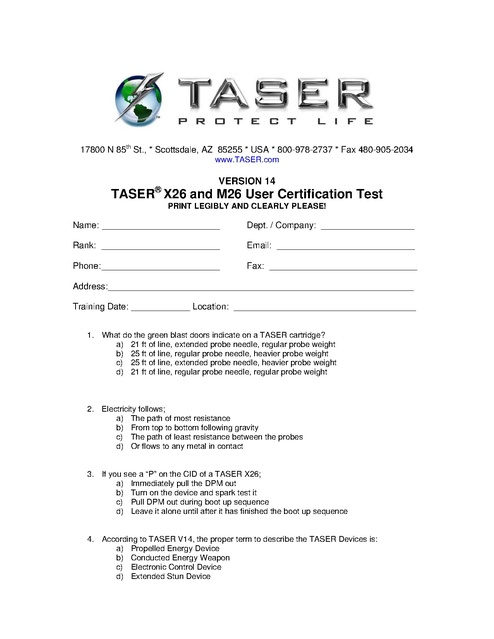Taser X26 M26 User Certification Test
Download original document:

Document text

Document text
This text is machine-read, and may contain errors. Check the original document to verify accuracy.
PROTECT L I F E 17800 N 85th St., * Scottsdale, AZ 85255 * USA * 800-978-2737 * Fax 480-905-2034 www.TASER.com VERSION 14 ® TASER X26 and M26 User Certification Test PRINT LEGIBLY AND CLEARLY PLEASE! Name: ________________________ Dept. / Company: ___________________ Rank: ________________________ Email: ____________________________ Phone: ________________________ Fax: ______________________________ Address:______________________________________________________________ Training Date: ____________ Location: _____________________________________ 1. What do the green blast doors indicate on a TASER cartridge? a) 21 ft of line, extended probe needle, regular probe weight b) 25 ft of line, regular probe needle, heavier probe weight c) 25 ft of line, extended probe needle, heavier probe weight d) 21 ft of line, regular probe needle, regular probe weight 2. Electricity follows; a) The path of most resistance b) From top to bottom following gravity c) The path of least resistance between the probes d) Or flows to any metal in contact 3. If you see a “P” on the CID of a TASER X26; a) Immediately pull the DPM out b) Turn on the device and spark test it c) Pull DPM out during boot up sequence d) Leave it alone until after it has finished the boot up sequence 4. According to TASER V14, the proper term to describe the TASER Devices is: a) Propelled Energy Device b) Conducted Energy Weapon c) Electronic Control Device d) Extended Stun Device 5. When illuminated, the Power Indicator LED on the M26 indicates: a) The battery level is acceptable b) Power to the circuitry only c) The laser sight is functioning properly d) The batteries need replacing 6. The 15, 21, and 25 foot cartridges propel the probes at a ___________ downward angle: a) 7 degree b) 8 degree c) 4 degree d) 21 degree 7. Firing the probes into the body of a subject even at close or point blank range is usually a better option than a drive stun with the cartridge removed because; a) It allows the person deploying the ECD to disengage and still deliver the affects of the ECD b) It allows the person deploying the ECD to drive stun away from the probes with the cartridge still attached and increase the affects if needed c) A drive stun with a cartridge removed will usually result in more significant “signature” marks than a probe deployment d) All of the above 8. A drive stun with the cartridge removed is sometimes not very effective because: a) It is usually difficult to maintain contact with a combative suspect. b) The spread of the contact points on the suspect is generally not large enough to cause NMI. c) A pressure point application on a combative subject may be difficult to achieve. d) All of the above 9. The human nervous system has three main components that work together as a system. Which of the three components functions to send signals to the brain about such things as relative body positioning and pain? a) Central nervous system b) Motor nervous system c) Sensory nervous system d) Century nervous system 10. The two phases of Shaped pulse technology are: _____________________ _____________________ 11. What nerves are responsible for voluntary skeletal muscle movement: __________________________ 12. According to the TASER V14 training DVD the term used for describing the incapacitating affects of the TASER ECD is; a) Electro-muscular disruption (EMD) b) Electro-muscular incapacitation (EMI) c) Neuro-muscular disruption (NMD) d) Neuro-muscular incapacitation (NMI) 13. The TASER X26 and M26 ECD both operate at a peak open gap 50,000 volts. A normal electrical wall outlet in the USA operates at about 110 volts and can be dangerous to a human. What is the main reason the electrical output of the TASER ECD is safer? a) Because the amps of the ECD are extremely low b) Because the amps are extremely high c) Because the wall outlet is pulsed energy d) Because the joule output of the ECD is 300 times greater 14. While a violent subject is incapacitated by the affects of the TASER ECD and it is reasonably safe to do so, cover officer(s) should attempt to control/cuff the subject under power. Doing so may; a) Reduce the need for additional cycles b) Reduce the likelihood the subject will roll during the cycle c) Reduce the potential of injury to the officer(s) because the subject is incapacitated only during the cycle d) All of the above 15. The probes are propelled from the TASER cartridge by: a) Primer propellant b) Compressed Argon gas c) Compressed Nitrogen d) Compressed blended gas (proprietary secret blend) 16. The TASER M26 or X26 high peak arcing voltage of 50,000 volts only occurs when the arc is required to jump a gap such as between the electrodes on the end of the M26 or X26, or when a probe lodges in loose clothing and must jump the gap to the body. When traveling across the human body, the peak voltage drops to approximately; a) 20,000 for the M26 and 15,000 for the X26 b) 10, 000 for the M26 and 5,000 for the X26 c) 5,000 for the M26 and 1,200 for the X26 d) 5,000 for the X26 and 1000 for the M26 17. The TASER X/M26 NMI Weapons affect the: a) Motor nervous system only b) Sensory nervous system only c) Sensory and motor nervous systems d) Cardiac system 18. The "TASER-Wave" electronic signals of the TASER X/M26 are effective: a) Through up to two inches of clothing. b) Through some types soft body armor. c) Through lightweight clothing. d) All of the above. 19. The TASER X26 will store what information for each trigger pull? a) Time, Date, Cartridge Number b) Time, Date, Duration, Body Temperature c) Date, Duration, Body Temperature, Temperature d) Time, Date, Duration, Battery Life, Temperature 20. The 21 foot standard cartridge has: a) Yellow blast doors b) Silver blast doors c) Green blast doors d) Orange blast doors e) Blue blast doors 21. When deploying probes, the TASER should generally be aimed at: a) Face b) Center of body mass c) The throat d) The head 22. After deploying the TASER X/M26 upon the "threat.” a) Immediately turn the unit off b) Be prepared to deliver additional cycles if necessary. c) Use the unit as a drive stun if the probes miss the threat or reload the TASER. d) Both B and C ADVANCED TASER® M26 NOMENCLATURE Identify the parts of the ADVANCED TASER A. B. C. D. E. F. G. H. I. Trigger Battery Cover TASER Cartridge Dataport Safety Switch Battery Cover Pin Front Sight & Rear Post Sights Built-in Laser Power Indicator ______ ______ ______ ______ ______ ______ ______ ______ ______ TASER® X26 NOMENCLATURE Identify the parts of the TASER X26 .... TI 2 .5 ,6 ,3 A. Trigger ______ B. Digital Power Magazine (DPM) ______ C. TASER Cartridge ______ D. Mechanical Sight ______ E. Safety Switch ______ F. DPM Release Button ______ G. Stainless Steel Shock Plate ______ H. Built-in Laser (pointing to beam) ______ I. Central Information Display J. Probes (CID) ______ ______ K. Low Intensity Lights ______ L. Serial Number Plate ______ M. Illumination Selector Switch ______ N. AFID Tags ______ 7





